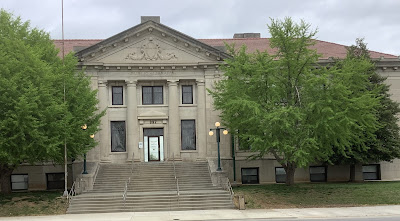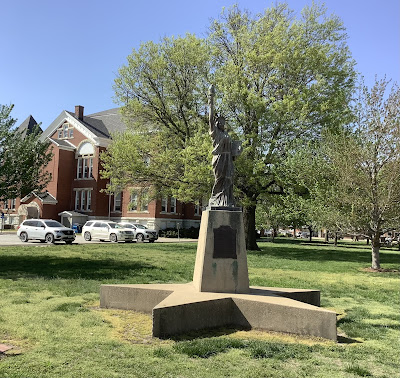This swath across northwest Kentucky has taken on a music theme. Central City had a monument to the Everly Brothers, as they gave an annual Labor Day concert there for fourteen years, starting in 1988, to raise money for a scholarship fund for local students.
It was his adaption of country music played with an assortment of stringed instruments, including the fiddle, banjo and mandolin. His most famous song, “Blue Moon of Kentucky,” was recorded by Elvis as the B-side of his first single for Sun Records in 1954. I failed to get a full immersion into his life, as despite an official state car in the the parking lot it wasn’t open. The car had a pro-coal sticker on it and an accompanying sticker discouraging the use of electricity to generate power. More common were signs in people’s yards protesting the introduction of solar energy installations.
My day in the motel began at three just as the rain commenced. I had lingered at the simple, basic library until then, making a dash to my sanctuary, half a mile away, when the first drops came. I sat by the window watching it fall nonstop until well after dark, fully vindicating my decision to motel it, especially when the rain came down in torrents. I had no longing, as I sometimes do, to be in my tent experiencing the elements. I would have been panicking over the possibility of being flooded.
The road was still damp in the morning and a mist hung in the air, but I fully trusted the forecast that had no rain in it and could enjoy being back on the bike. The road I was on paralleled the Bluegrass Parkway Interstate drawing all the traffic to it, so I had the road all to myself. It was the finest of cycling through rolling, forested terrain. It was another day of over four thousand feet of climbing in just under one hundred miles.
The route included Kentucky’s lone Statue of Liberty in Leitchfield. It was another at the most common place for them, by the courthouse, except it wasn’t there. Two women inside were surprised I couldn’t find it, as they knew it was there, though they had come to take it for granted and couldn’t remember its precise location. They both peered out their second floor window but couldn’t spot it.
One went outside with me and was flummoxed that she couldn’t remember where it was. She asked a city worker doing some landscaping if he knew where it was. Indeed he did, as he had moved it to the hospital a couple of years ago and then just recently transferred it to the auxiliary courthouse a couple blocks away when the hospital was torn down. He told me it was inside the courthouse.
I had to be let into the courthouse and led down a hallway where Lady Liberty stood in isolation at the end of the hall out of public view by someone’s office. Two ladies there were happy to show it to me, but they knew nothing of its origins, donated by the Boy Scouts in 1950 commemorating its fortieth anniversary. They knew there were others scattered around the country, but they didn’t realize this was the only one in Kentucky.
They, as those at the courthouse, oozed southern hospitality, expressing a genuine interest in my travels, more than the usual perfunctory queries. I had more than a passing conversation with all of them. The man who had shuttled the statue around even shook my hand at my parting. Their accents also indicated this was the South.






















































